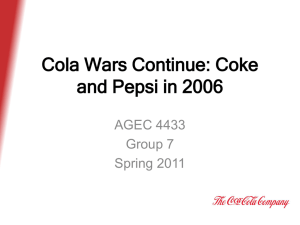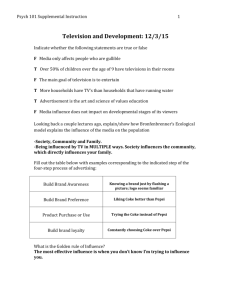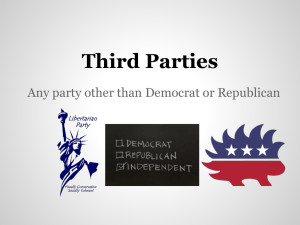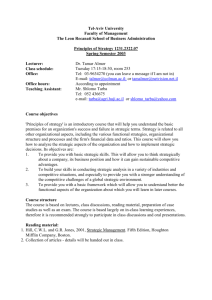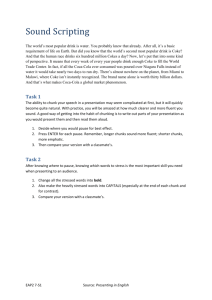Case: Cola Wars Continued: Coke versus Pepsi in the Twenty
advertisement
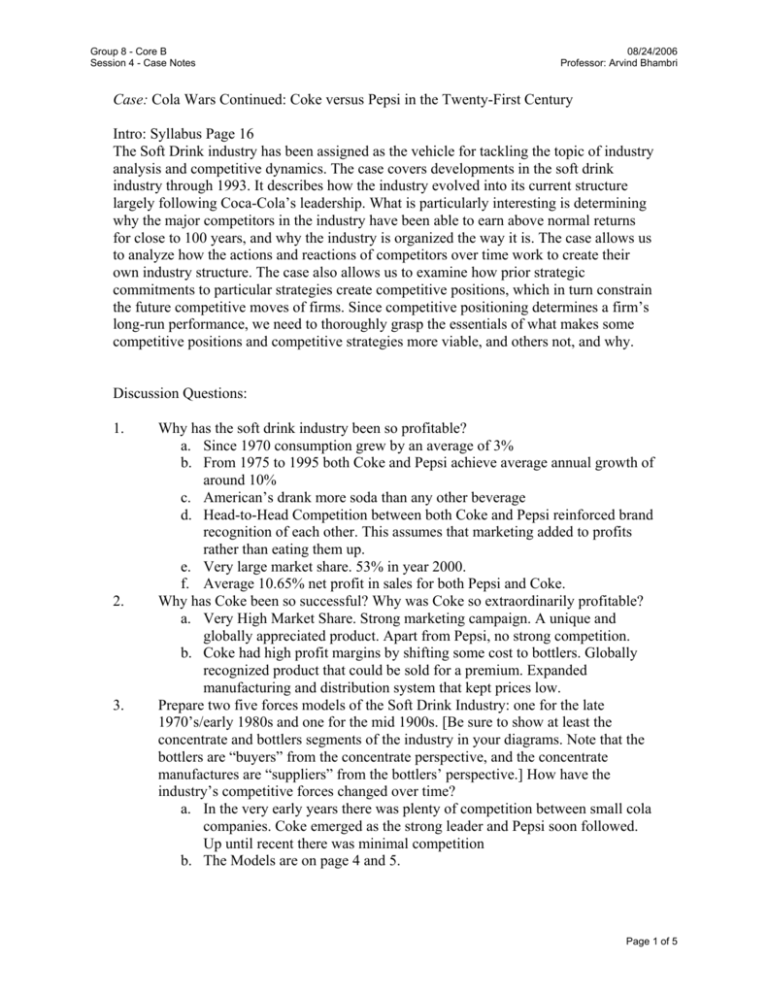
Group 8 - Core B Session 4 - Case Notes 08/24/2006 Professor: Arvind Bhambri Case: Cola Wars Continued: Coke versus Pepsi in the Twenty-First Century Intro: Syllabus Page 16 The Soft Drink industry has been assigned as the vehicle for tackling the topic of industry analysis and competitive dynamics. The case covers developments in the soft drink industry through 1993. It describes how the industry evolved into its current structure largely following Coca-Cola’s leadership. What is particularly interesting is determining why the major competitors in the industry have been able to earn above normal returns for close to 100 years, and why the industry is organized the way it is. The case allows us to analyze how the actions and reactions of competitors over time work to create their own industry structure. The case also allows us to examine how prior strategic commitments to particular strategies create competitive positions, which in turn constrain the future competitive moves of firms. Since competitive positioning determines a firm’s long-run performance, we need to thoroughly grasp the essentials of what makes some competitive positions and competitive strategies more viable, and others not, and why. Discussion Questions: 1. 2. 3. Why has the soft drink industry been so profitable? a. Since 1970 consumption grew by an average of 3% b. From 1975 to 1995 both Coke and Pepsi achieve average annual growth of around 10% c. American’s drank more soda than any other beverage d. Head-to-Head Competition between both Coke and Pepsi reinforced brand recognition of each other. This assumes that marketing added to profits rather than eating them up. e. Very large market share. 53% in year 2000. f. Average 10.65% net profit in sales for both Pepsi and Coke. Why has Coke been so successful? Why was Coke so extraordinarily profitable? a. Very High Market Share. Strong marketing campaign. A unique and globally appreciated product. Apart from Pepsi, no strong competition. b. Coke had high profit margins by shifting some cost to bottlers. Globally recognized product that could be sold for a premium. Expanded manufacturing and distribution system that kept prices low. Prepare two five forces models of the Soft Drink Industry: one for the late 1970’s/early 1980s and one for the mid 1900s. [Be sure to show at least the concentrate and bottlers segments of the industry in your diagrams. Note that the bottlers are “buyers” from the concentrate perspective, and the concentrate manufactures are “suppliers” from the bottlers’ perspective.] How have the industry’s competitive forces changed over time? a. In the very early years there was plenty of competition between small cola companies. Coke emerged as the strong leader and Pepsi soon followed. Up until recent there was minimal competition b. The Models are on page 4 and 5. Page 1 of 5 Group 8 - Core B Session 4 - Case Notes 4. 5. 6. 08/24/2006 Professor: Arvind Bhambri Compare the economics of the concentrate business to the bottling business: why is the profitability so different? Why do concentrate producers want to integrate into bottling? a. Concentrate business: Concentrate producers were dependent on the Pepsi and Coke bottling network to distribute their products. Starting and maintaining a concentrate manufacturing plant involved little capital investment in machinery, overhead, and labor. Significant costs were for advertising, promotion, market research, and bottler relations. Producers negotiated with bottlers’ major suppliers. One factory could server the entire united states b. Bottlers: Purchased concentrate, added carbonated water, added corn syrup, bottled it, and delivered it to customer accounts. Gross Profits were high but operating margins were razor thing. Bottlers handled merchandising. Bottler’s could also work with other non-cola brands. What is happening in the soft drink industry? How do the major developments affect smaller competitors? a. A rise of non-cola beverages. b. Bottled water. c. Sports drinks. d. Tea based drinks. e. Juice based drinks. f. Dairy based drinks. g. Non-carb based drinks. h. Some smaller competitors have been purchase (SoBe by Pepsi) while others now have to face stiff competition from Pepsi and Code. How was Pepsi able to gain share in 1950s? In the 1960s and early 1970s? After the Pepsi Challenge? Consider each period separately, and be specific. Why didn’t Coke respond? What provoked the eventual response by Coke beginning in the 1980s? a. 1950s: Alfred Steele, a former Coca-Cola marketing executive, became Pepsi’s CEO. Pepsi introduced “Beat Coke” theme Pepsi introduced 26ounce bottle, targeting family consumption. Coke stayed with its 6.5ounce bottle. For reference McDonalds Supersize Coke was 42 ounces. b. 1960s: New CEO, new slogan, “Pepsi Generation.” By focusing on the younger population Pepsi narrowed Coke’s lead to a 2-to-1 margin. Pepsi had larger and more modern bottling facilities. Both groups starting adding new soft drink brands. Pepsi merged with Frito-lay to become PepsiCo. Coke wouldn’t even mention Pepsi’s name during meetings. c. Pepsi Challenge: Starting in Texas, Pepsi’s bottlers had public blind taste tests to prove that Pepsi tasted better. This marking stunt increased sales significantly. Pepsi gained a 1.4 point lead in food store leads. Coke countered with rebates and renegotiations with franchise bottlers. d. Coke’s response: Coke got a new CEO, Roberto Goizueta. Coke cut costs (used corn syrup instead of sugar), doubled advertising spending, and sold off most non-CSD business. Diet Coke was introduced to become a phenomenal success. Coke tried to be innovative by changing its formula, Page 2 of 5 Group 8 - Core B Session 4 - Case Notes 7. 08/24/2006 Professor: Arvind Bhambri but that failed miserably. Coke introduced 11 new products. Pepsi emulated most of Coke’s strategic moves. Will Coke and Pepsi sustain their profits through the next decade? What would you recommend to Coke to ensure its success? To Pepsi? a. It should not be a problem to sustain their profits through the next decade. The more important question is whether they can sustain their historical rate of growth. To do so they need to seek out new markets and increase consumption in currently developing markets such as China and India b. I would recommend Coke to focus on its emerging international market. I would also encourage Coke to expand their offerings. I think Coke made a serious mistake when they failed to purchase Quaker Oats and with it the Gatorade Sports Drink line. If Coke focuses on several beverage offerings they can leverage their internal bottling and distribution infrastructure. Different types of beverages can keep Coke’s overall profit intact when there is a shift in consumer preference, such as a shift from soft drinks to healthier alternatives (Think of the effect Atkins had on the food industry) c. For Pepsi I would basically recommend the same thing as Coke. I would encourage Pepsi to focus on its line of soft drink alternatives, which seem to have a much stronger market share than Coke’s line. I would encourage Pepsi to only compete with Coke when it is profitable to do so. Page 3 of 5 Group 8 - Core B Session 4 - Case Notes 08/24/2006 Professor: Arvind Bhambri Alternative beverages (Potential Entrants) 1990s Threat of New Entrants Bargaining Power of Suppliers Cheap for alternatives (no more price ware between the colas). Shelf space is important and can be difficult for new entrants. A few dominant suppliers with very strong brands. Everyone is a consumer, Smaller brand are strong enough to have influence Industry Competitors Bottlers (Buyers) Concentrate (Suppliers) Rivalry among existing firms Bargaining Power of Buyers Bottlers are generally owned by Cola companies. There are only handful of independent bottlers. They are more consolidated and have a little greater individual power Threat of Substitute Products or Service There is no cost to switch between Pepsi and Coke other than personal taste. However alternative beverages present a strong threat to bottom lines. Other Beverages (Substitutes) Page 4 of 5 Group 8 - Core B Session 4 - Case Notes 08/24/2006 Professor: Arvind Bhambri Alternative beverages (Potential Entrants) 1970/80s Threat of New Entrants Almost impossible for success with Cola. There is enough competition between Coke and Pepsi and their new products to keep most alternatives from entering the market. Bargaining Power of Suppliers A few dominant suppliers with very strong brands. Everyone is a consumer, Industry Competitors Bottlers (Buyers) Concentrate (Suppliers) Rivalry among existing firms Bargaining Power of Buyers Bottlers are scattered, have minimal profits, and can not integrate backwards into supply Threat of Substitute Products or Service There is no cost to switch between Pepsi and Coke other than personal tase Other Beverages (Substitutes) Page 5 of 5

